Stories
Trish Beach
1947-
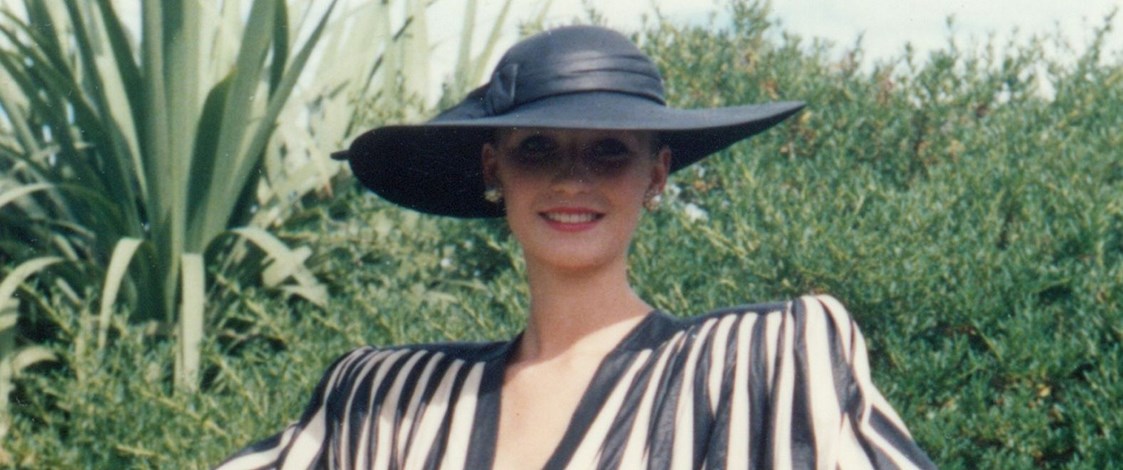
Winning three Awards (including the Supreme Award) in the 1987 Benson & Hedges Fashion Design Awards thrust reluctant star Trish Beach into the spotlight.
In one of the many newspaper and magazine articles written about her after the event, she confessed to being somewhat overwhelmed by the media attention.
A former high-school English teacher, who came originally from Hawkes Bay, Trish spent the early years of her marriage farming with her husband Graham in Southland. In 1981, the couple purchased an export apple orchard in Pakowhai just outside Napier. It was here that she started her business, working from home, designing and making high fashion lambskin garments. Although she received no formal design training, she had sewn all her own clothes (using Vogue patterns) since she was a teenager.
Initially, Trish intended producing leatherwear for children. But, as she anticipated, the Auckland retailers to whom she showed her sample range considered leather too expensive an item for children at that time. As a consequence, her own young children ended up wearing a lot of lambsuede garments. She recalls her daughter, oblivious to the exclusivity of her clothing, arriving home from school and saying "Mummy, I just want to wear normal clothes like everyone else."
When the childrenswear venture didn’t work out, Trish turned her hand to women’s leather fashion and found a receptive market. Val Svendsen of Memsahib, who owned stores in Auckland and Wellington, was the first to place a sizeable order. She became a major stockist along with Basilea in Parnell and Limited Editions in Dunedin. Restricting the sale of the Trish Beach label to just a few exclusive stores was always Trish’s intention. "It was a small scale, home-based manufacturing business," she says, "and I never envisaged turning out hundreds of items. I was a slow methodical worker. You couldn’t rush things when you were cutting into costly skins." She was assisted by one other machinist and used the services of out-workers when necessary. Graham Beach helped with marketing.
Trish’s designs, which included capricious casuals, sophisticated city ensembles and evening gowns, reflected her love of classic, timeless styling. A big Armani fan, she claims she wasn’t interested in trends. She designed original pieces that could be worn for a long time thus justifying their expense. She says she occasionally comes across a classic trench-coat she produced in the 1980s, still being worn today and looking just as fashionable.
Trish worked exclusively in lambskin sourced from NZ Light Leathers of Timaru, the largest tanner of finished garment leather in New Zealand. As a result of continuing research and advanced technology, the skins the tannery produced were ultra-thin, supple and super-soft. "They could be draped, folded, gathered, pleated or tucked just like any other fabric," says Trish. She also took advantage of the tannery’s extensive colour library, dreaming up such stunning combinations for her designs as mimosa and poppy red, nutmeg and charcoal, sulphur yellow and jade, and fuchsia and periwinkle blue.
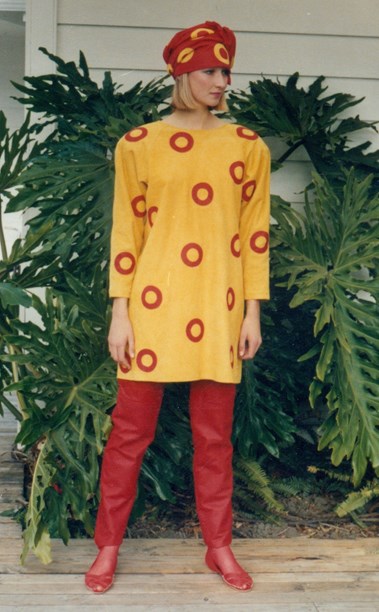
Trish Beach lambskin tunic and pants with matching turban, 1985.
Impressed by what Trish was achieving with their product, NZ Light Leathers commissioned her to put together a range of high fashion garments to promote their skins at a World Leather Fair in Paris.
A downturn in the footwear industry in the 1980s freed New Zealand tanners to concentrate on the production of decorative leather finishes for clothing. This provided a greater incentive for fashion designers to get creative with skin. The introduction of the Leather Industry Award in the Benson & Hedges Fashion Design Awards in 1986 further attested to the growing popularity of leather as a fashion medium. The Award, presented by the NZ Tanners Association for excellence in fashion leather or sheepskin, attracted a diversity of designs across all categories. Appliqued, painted, quilted and constellated with beads, they dispelled the notion that leather clothing was confined to biker jackets and sheepskin coats.
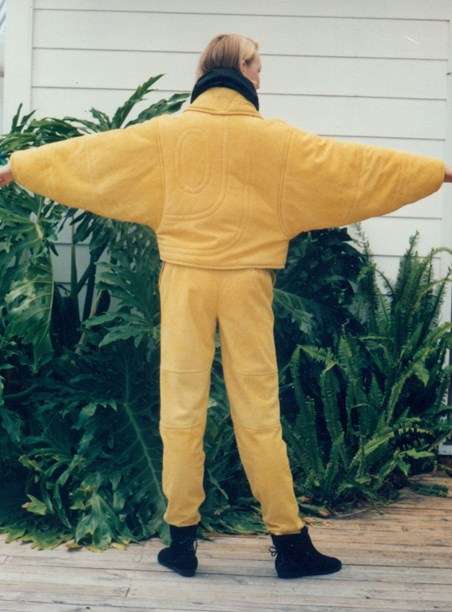
The Benson & Hedges Fashion Design Awards provided Trish Beach with a showcase in which to demonstrate the versatility of lambskin and her versatility as a designer.
The three lambskin designs submitted by Trish in 1986 represented her three areas of specialisation – leisurewear, high fashion and eveningwear. Each design made it through to the finals but it was a silk-lined dress and jacket ensemble in navy blue and cream that took the judges’ eye. It won the High Fashion Daywear Award.
Later that year, Trish and fellow Award-winners Konstantina Moutos and Roz Mexted were invited to show a selection of garments at a BMW Charity Gala at the Sheraton Hotel in Auckland to benefit the Cot Death Division of the National Children’s Health Research Foundation. Among the other participating designers were Colin Cole, Adrienne Winkelmann and Patrick Steel. That same year, Trish also took part in a fashion parade in the gardens of Government House in Wellington.
A combination of Renaissance richness and 80s’ power dressing, the claret silk velvet gown that won Trish the After-Five High Fashion Award in the 1987 Benson & Hedges Awards, gave the impression of the wearer having been poured into it. Moulded to the hip, with the skirt falling into a short train, it had long tight sleeves, shoulders out-to-there and a deep plunging neckline at the back, set off with long strands of pearls.
The dark green strapless dress Trish made for herself to wear to the event was also silk velvet, a fabric she describes as being "notoriously difficult to sew."
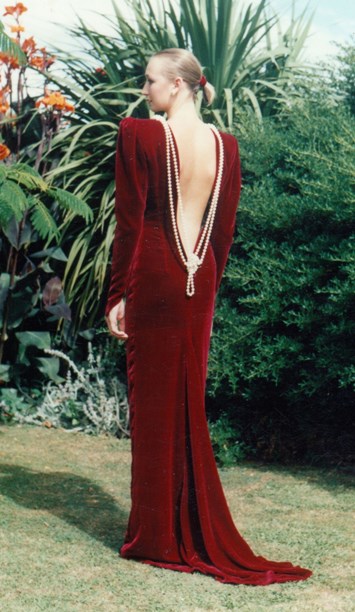
Trish Beach claret velvet evening dress, winner of the After-Five High Fashion Award, Benson & Hedges Fashion Design Awards, 1987.
For her Leather and Supreme Award-winning lambskin separates, Trish appropriated elements of menswear. Comprising a swaggering black greatcoat, loose-fitting grey trousers, a black leather beret worn at a nonchalant angle, and a short-sleeved top and scarf decorated with stitched-on leather polka dots, the ensemble exemplified throwaway chic at its most luxurious. Trish’s house model 18-year-old Jane Fullerton-Smith wore the prize-winning outfit. It was her first major modelling assignment.
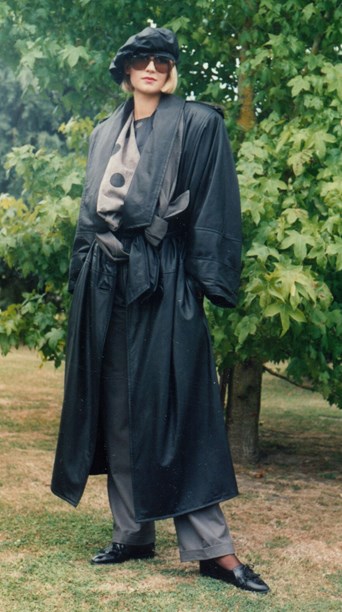
Trish Beach’s double-prize-winning entry in the Benson & Hedges Fashion Design Awards, 1987. Comprising co-ordinated lambskin pieces, it won both the Leather and Supreme Awards.
The publicity generated by Trish’s triple win elicited trade enquiries from the US and Japan but operating at an international level had never been on her agenda. At the end of the 1980s, she exited the fashion world and moved with her family to Dunedin where she devoted her time to building the new business (not fashion-related) that she and her husband set up.
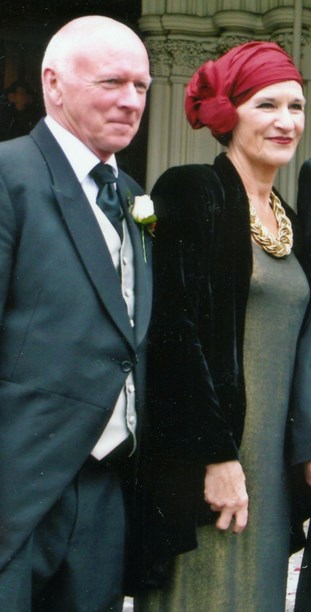
Trish Beach with her husband Graham at their son’s wedding in 2012. She is wearing a matte gold lame dress and black silk velvet coat of her own design and a red silk turban. Image © Trish Beach.
Although no longer designing commercially, Trish Beach retains her interest in leather as a fashion medium. Using skins she has kept, and deconstructing existing leather garments, she makes quilted lambsuede jackets for her three grand-children and miscellaneous fashion items for other members of the family.
Text by Cecilie Geary. Banner image of a full-sleeved Trish Beach jacket, cinched at the waist and worn with a slim skirt and broad-brimmed hat by Ruby Crawford. The jacket was Highly Commended in the High Fashion Daywear category, Benson & Hedges Fashion Design Awards 1987.
Last published April 2017.